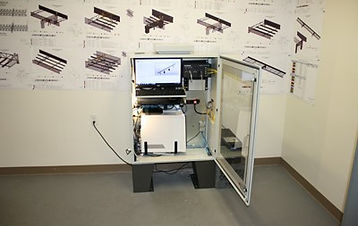
.png)
Tomorrow's Technology Today
Optical Sensing Solutions, IoT

.jpg)

Mount McKinley
Chulitna Bridge Alaska
About The Bridge and Objective
The Chulitna Bridge comprises part of the only main highway into Denali National Park in Alaska. Given the extreme weather conditions and earthquakes the purpose of the monitoring system installation is to maintain safety and to help classify the bridge ratings by providing continuous monitoring data over many years. Due to the extreme cold, optical sensors are the only sensor type that will reliably survive in this harsh environment. As a Unique feature all data Acquisition control panel equipment is located 1.5 miles away at the Princess resort Lodge using existing underground telecommunications fiber to stream all information to the remote optical control panel. This project was the first in the United States to use dynamic remote monitoring with a 26 mile standard range using existing buried optical communications fiber. This eliminated the need for access to the bridge to maintenance any hardware allowing all passive optical sensors to stream to the remote location dynamically. ChM4 was chosen because of its expertise in optical sensors giving extensive training to Alaska University students to understand and use optical sensing systems. The University wrote many white papers and thesis based on this sophisticated passive optical system. This project was the university's first exposure to this technology for a real world application. The FHWA and Alaska DOT grant to the University of Alaska funded the project looking for a reliable system to use in harsh conditions. ChM4 software IntelliOptics® was designed for the university virtual servers with a powerful graphical interface and SQL databases to maintain bridge data for long term monitoring. Seismic activity occurred at the Chulitna bridge area often which lead to adding the University of Alaska remote seismic systems to IntelliOptics® software to compare to real time seismic data.
Following the white papers generated by the University of Alaska describe the system fully and its finding over time that are of great interest to the bridge monitoring efforts in the United States.

University of Alaska Fairbanks whitepaper on bridge installation

Simple model built used for pre-assemble of optical sensor system and location approvals. The model also used in the cloud SQL user interphase software IntelliOptics®.

Sensor System Map
ChM4 designed the system to have only one DAU combining the newest optical sensors. The system was hosted on the cloud allowing access from any location with proper credentials. The monitoring system provided (40) Luna os3155's, (24) os3100 arranged temperature compensated by (8) os4100's in sets for Rosettes strain measurements to assess effects of heavy loads and torsional beam movement, (2) os4350's for absolute air temperature for environmental reasons, (4) os7500's accelerometers for bridge signatures, (4) FBG Korea tilt meters for rocker bearing movement verification, (4) Kaisen displacement sensors to assess effects of rocker bearing vertical lifting from bearing pads due to load, weather and seismic events on support rocker arms. The data acquisition interrogator (1) Luna optical interrogator, sm0416 multiplexer and a high speed telecom switch to sync the data from the sm0416 multiplexer mounted on the bridge to a Luna interrogator located in the resort separated by 1.5 miles. Four underground telecom fibers was available from the bridge to the resort. The system also incorporates a Bosch 36x zoom/pan/tilt with infrared night vision camera that is used by Alaska DOT and the University of Alaska engineers for remote monitoring of structural and security issues.

Optical Control Panel
ChM4 placing the optical interrogator 1.5 miles from bridge in a resort outside of Denali park keeps expensive processing equipment in a controlled environment and DOT's from having to access equipment in dangerous awkward locations in remote areas with extreme weather conditions in Alaska. Some of these locations become impassable were this resort is occupied with staff year round and trained to assist if needed.
Bridge Multiplexer with Telecom Switch
ChM4 designed the bridge panel with a sensor multiplexer and fast telecom switch to sync with a dynamic optical instrument 3 mile round trip. All optical sensors raw data is transported over existing buried optical communications fiber. This is the first optical infrastructure monitoring system to use existing telecommunication infrastructure to transmit optical sensor wavelengths to a remote interrogator at that distance in the United States. Much greater distances can be achieved for more than 26 miles and further with repeaters. The IoT designed cities having central command and control centers where all information is interpreted at these locations for our smart cities of the future can be achieved.



IntelliOptics® structural health monitoring software, developed by ChM4 is a powerful, user-friendly interface that collects data from multiple sensor types and displays status information via one centralized program. Also see our software section for more information and our Intelli-Insight® predictive analysis module for maintenance of critical structures.
Equipment Sharing Concept
ChM4 suggested this to the University to prove this type of setup for future sensing systems needs in extremely remote areas with distances greater than 100 miles from a central optical interrogator is possible with repeaters with existing telecommunications fiber even through switching hubs. This type of arrangements could allow one location to monitor multiple bridges with one interrogator with a master switch system; we call this equipment sharing. This type of monitoring system will be common in our future.
 |  |  |
|---|---|---|
 |  |  |
 |  |  |
 |  |  |
 |  |  |
ChM4 structural health monitoring installation Drawings of FBG optical sensors, control panels and software turnkey project.

